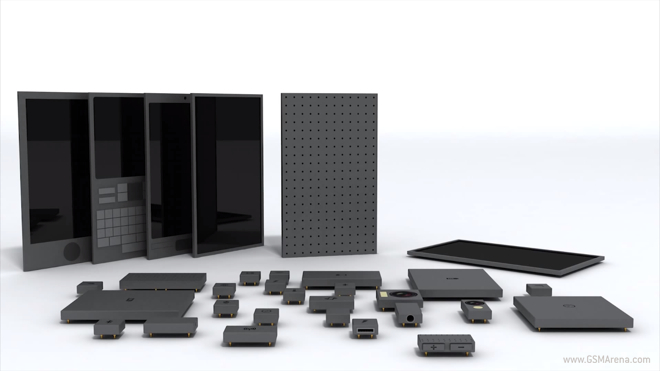What if you could take “blocks” of battery, memory storage, camera, GPS, and other features and put them together into one customizable and repairable mobile phone? The idea sounds like the farthest thing from short-lived iPhones and Samsung smartphones the market offers today.
Meet Phoneblok, a concept mobile phone built with detachable component blocks. With its Lego-like concept, Dave Hakkens’ modular phone project has attracted attention from millions of mobile users around the world. The Netherlands-based designer launched a Thunderclap campaign to get the word out on his concept phone and to date has gathered more than 660,000 supporters, with an estimated social reach of more than 250 million.
Why all the buzz? Because the Phoneblok concept offers a tantalizing possibility to users: a repairable smartphone.
Today’s latest smartphones come packaged with all kinds of specs but one. Lightning processing speed – check. Wide range of connectivity options – check. Dual phone camera at 2-digit megapixels – double check. But what doesn’t come with the box is electronic repairability. This means that once your expensive, feature-packed smartphone gets dropped in the water or cracks its screen, you only have very few options left aside from throwing the whole thing into the trash bin.
Which doesn’t only spell money lost but wasted resources as well. As Hakkens and others have pointed out, often an electronic gadget gets replaced or thrown out because of one broken or malfunctioning component, with the rest of the unit in perfect working condition. According to e-waste statistics mobile phones get replaced every 22 months. The world dumps 20-50 million metric tons of electronics but recycles less than 20%.
Current gadget manufacturing technologies do not help, either. Sophisticated units like Apple’s iPhone and Samsung’s Galaxy products are made in highly specialized, highly specific assembly lines. This means that components in the smartphone unit are deliberately designed to fit so close together in order to preserve function, portability, and aesthetics. Sadly, this also means that the unit has very low repairability as it would be difficult if not impossible to replace one component without potentially damaging other sensitive parts. So even though the loose chip deep inside your smartphone can be replaced, taking the unit apart will probably make the problem worse due to the unit’s manufacturing design.
Apart from low repairability scores, successive new product releases from top brands make it easier for users to say goodbye to a working (albeit outdated) smartphone. Often consumers are forced to buy entire new units or fall behind the newest mobile tech trend.
Phoneblok aims to address both issues (repairability and mobile tech obsolescence) by making components in individual, detachable ‘bloks’. For example, if the screen ‘blok’ breaks users can simply detach the blok and replace it with a new or better one. The same goes for every kind of bloks. Parts can be upgraded without having to change or buy accessories (docks, chargers, etc.) This design concept also allows for customization: heavy Internet users can opt for bigger batteries while avid photographers can swap audio parts for bigger phone cameras.
Hakkens envisions an app store where users can buy, review, or sell old bloks. More dubiously, he anticipates manufacturers taking part in the Phoneblok store to sell and develop blocks.
Wonderful though Phoneblok may be, its design and engineering concepts have prompted criticism from the online community. Some has pinpointed the breadboard-type base as one major flaw in the concept. The base just seems too good to be true in terms of high quality signaling paths required for today’s sophisticated smartphone units.
Also, the idea of fitting different component blocks from different manufacturers and expecting them to work together seamlessly as a whole is a distant possibility at best. Another pitfall in Phoneblok’s campaign is the question of getting the said manufacturers to churn out the blocks for the modular phone – presumably while they compete with each other and try to make a profit as well. A unanimous consensus among industry leaders and manufacturers to set aside self-interest for the sake of selfless do-goodery is highly improbable, yet this is one of Phoneblok’s major prerequisites for success.
The Phoneblok campaign will end on October 29 but there are no prototype or product releases waiting for its supporters. Rather the campaign hopes to capture the attention of key manufacturers and developers who can produce the concept mobile phone.
Phoneblok’s concept might never be translated into feasible reality anytime soon, at least not with current economic and technological restraints. Yet despite its shortcomings as a concept project, Phoneblok’s message continues to reverberate among mobile users. Its essence will continue to echo in every area of modern living that needs to undergo radical transformation in order to adapt to new environmental and global conditions. It may be green transport breakthroughs – electric cars replacing fossil-fueled ones. It may be manufacturing – 3D and 4D printing instead of mass production. These sustainability developments and Phoneblok’s message are the same: active involvement in the way our choices not only impact our environment but shape our lives as well.
What do you think of the Phoneblok? Is it too good to be true or is it the (near) future of smartphones? Share your thoughts in the comments below.




Leave a Comment